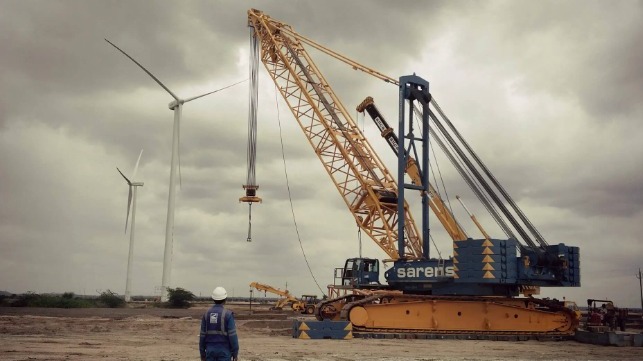UK's Onshore Wind Sector Experiences Strong Growth, Reaching 14GW Mark

[By Sarens]
The United Kingdom aims to generate 50% of its electricity from renewable sources by 2030 and reduce its greenhouse gas emissions by 68% compared to 1990 levels. Planned onshore wind farm installations in the UK could generate up to 31,000 direct and indirect jobs by 2035.
To date, the UK has installed more than 14 GW of onshore wind power and has a pipeline of planned projects totaling 23 GW. These figures demonstrate the great progress the country is making in the construction of onshore wind power plants, which will help to achieve the net zero target by 2035.
In this context, Sarens, global specialist in heavy lifting, engineered transport and crane rental, is positioning itself as the leading company in the construction and maintenance of onshore wind farms. With state-of-the-art equipment, value engineering and one of the world's largest inventories of cranes, conveyors and special rigging equipment, the company is able to meet any challenge, offering creative and intelligent solutions in the construction of onshore wind power plants.
Its extensive experience in this field endorses Sarens as a reference in maintenance and development of onshore wind power plants. The Belgian company has extensive international experience in the development and maintenance of projects related to wind energy, such as the one developed in Sweden in the Markbygden wind farm, in the project for Navantia in St.Brieuc or even South Africa in the Karusa and Soetwater plants. The most recent of all in La Rochelle, where Sarens has transported parts of up to 980T and 62 meters to the St.Nazaire wind farm.
These jobs demonstrate how important it is to have specialists capable of ensuring project feasibility, minimizing cost reduction and efficiency throughout the execution phase. Sarens will continue its efforts to provide companies and public institutions with the tools necessary for the wind industry to continue to expand in the region and move closer to its international environmental targets.
For the UK, onshore wind power is key to meeting its 2030 climate and energy targets, which include generating 50% of its electricity from renewable sources and reducing its greenhouse gas emissions by 68% from 1990 levels.
The development of onshore wind energy for the UK also means job creation, especially in rural and disadvantaged areas, where wind turbines can be installed. According to a study by RenewableUK the planned installations could generate up to 31,000 direct and indirect jobs by 2035. It will in turn be advantageous for citizens as it can lower consumers' electricity bills, as onshore wind power is one of the cheapest ways to generate electricity. According to one government estimate, the levelized cost of onshore wind could be around £40/MWh by 2025, which would make it cheaper than gas and nuclear.
To achieve these ambitious targets and enjoy the benefits, by 2030 the UK would need to build at least 35 GW of onshore wind power. This implies that an installation rate of around 2 GW per year would be required. In the second quarter of 2023, a record 1.5 GW of power was planned at just 18 sites, again suggesting a significant increase in onshore wind power in the future.
Currently, 84 sites are in the pre-application phase, and are expected to submit a full application for a total of 7.1 GW in the next few years. In turn, there are 95 sites with 6.1 GW currently in the planning phase and awaiting approval. Finally, planning permits have been granted for 8.1 GW at 332 sites, with construction likely to begin in the next few years.
The average time for completion of a large-scale wind farm from submission to planning is about five years. We should therefore expect projects submitted in 2019 to be built in the near future, assuming political and environmental factors are conducive to full construction.
The Sarens team has extensive experience in the UK, where it has recently been able to work on the Hinckley Point C power station, using the Big Carl, its most advanced crane and the largest in its repertoire. Sarens has also been able to contribute to projects such as the one carried out at the Fawler refinery, where it used a mobile lifting gantry capable of lifting loads of up to 1,250 tons for its clients Fluor and ExxonMobil.
The products and services herein described in this press release are not endorsed by The Maritime Executive.
